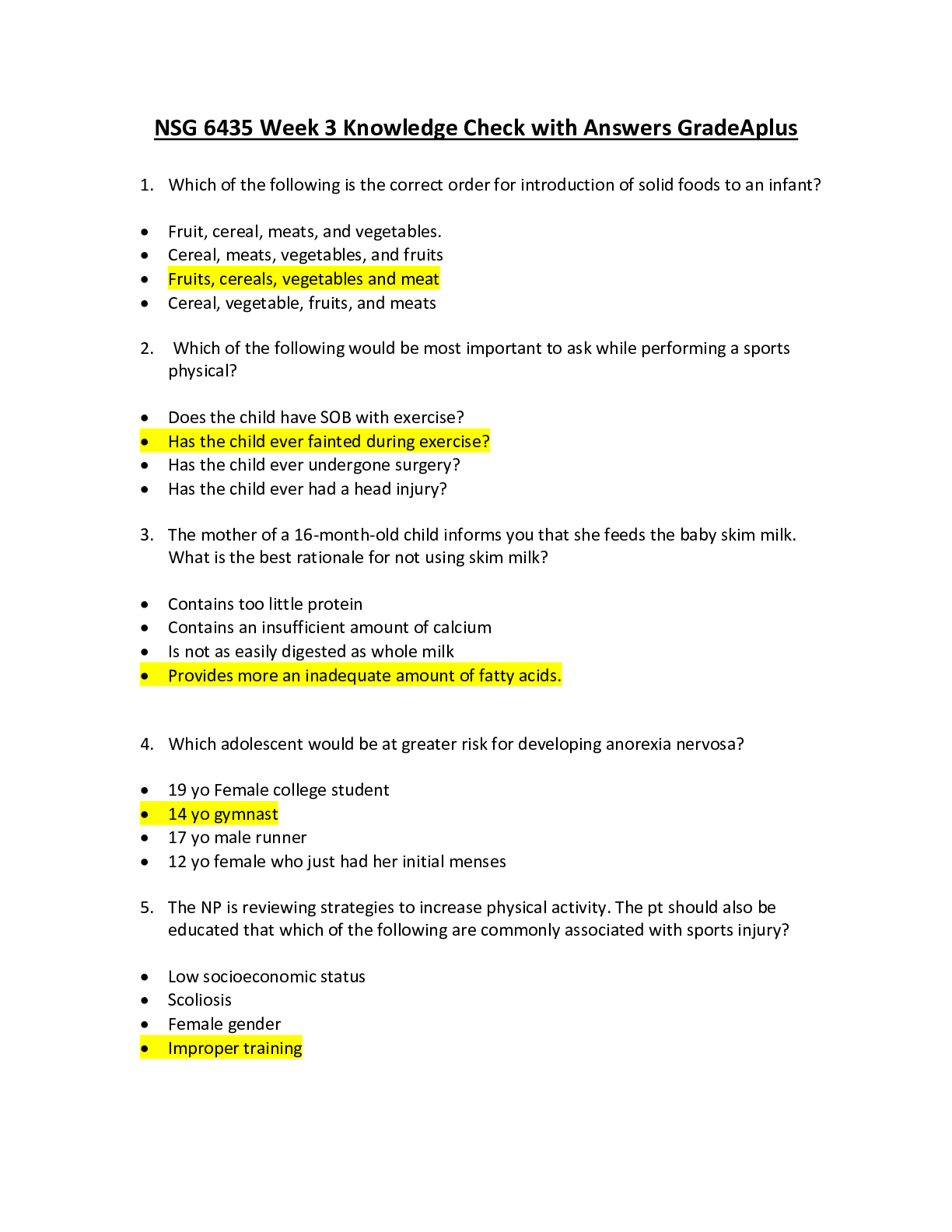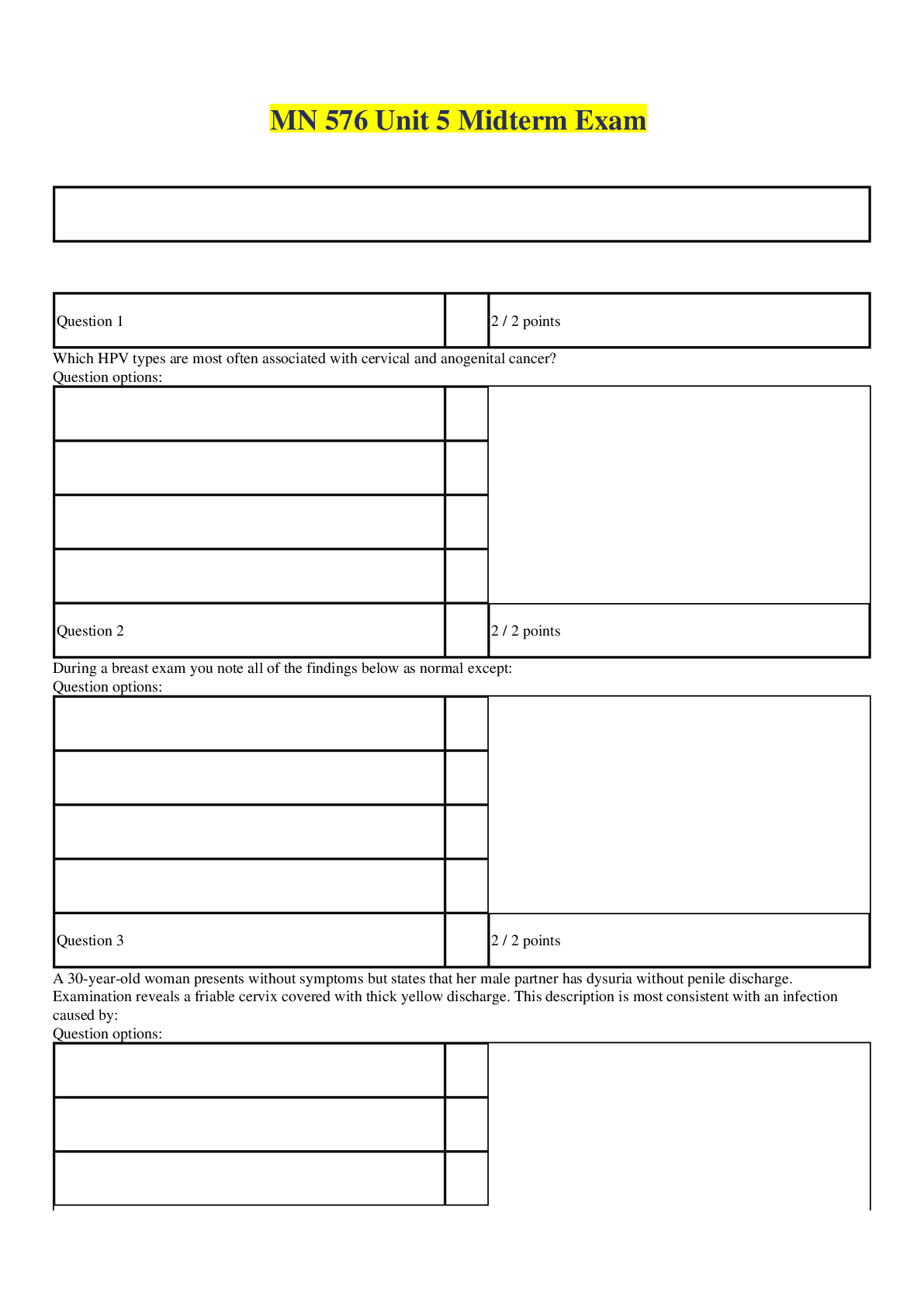*NURSING > EXAM > NSG5003 Week 3 Knowledge Check Quiz / NSG 5003 Week 3 Knowledge Check Quiz (Latest, 2020): South Uni (All)
NSG5003 Week 3 Knowledge Check Quiz / NSG 5003 Week 3 Knowledge Check Quiz (Latest, 2020): South University ( Verified Answers , Download to Score A)
Document Content and Description Below
NSG5003 Week 3 Knowledge Check Quiz / NSG 5003 Week 3 Knowledge Check Quiz: Advanced Pathophysiology: South University South University NSG5003 Week 3 Knowledge Check Quiz: Advanced Pathophysiology Qu... estion 1 (0.5 points) Oncogenes are genes that are capable of: Question 1 options: a) Undergoing mutation that directs the synthesis of proteins to accelerate the rate of tissue proliferation b) Directing synthesis of proteins to regulate growth and to provide necessary replacement of tissue c) Encoding proteins that negatively regulate the synthesis of proteins to slow or halt the replacement of tissue d) Undergoing mutation that directs malignant tissue toward blood vessels and lymph nodes for metastasis Question 2 (0.5 points) Burkitt lymphomas designate a chromosome that has a piece of chromosome 8 fused to a piece of chromosome 14. This is an example of which mutation of normal genes to oncogenes? Question 2 options: a) Point mutation b) Chromosome translocation c) Gene amplification d) Chromosome fusion Question 3 (0.5 points) In childhood neuroblastoma, the N-myc oncogene undergoes which type of mutation of normal genes to oncogenes? Question 3 options: a) Point mutation b) Chromosome fusion c) Gene amplification d) Chromosome translocation Question 4 (0.5 points) Which aberrant change causes the abnormal growth in a retinoblastoma? Question 4 options: a) Proto-oncogenes are changed to oncogenes. b) The tumor suppressor gene is turned off. c) Genetic amplification causes the abnormal growth. d) Chromosomes 9 and 21 are fused. Question 5 (0.5 points) Two hits are required to inactivate tumor suppressor genes because: Question 5 options: a) Each allele must be altered, and each person has two copies, or alleles, of each gene, one from each parent. b) The first hit stops tissue growth, and the second hit is needed to cause abnormal tissue growth. c) Tumor suppressor genes are larger than proto-oncogenes, requiring two hits to effect carcinogenesis. d) The first hit is insufficient to cause enough damage to cause a mutation. Question 6 (0.5 points) Chronic inflammation causes cancer by: Question 6 options: a) Increasing vasodilation and permeability that alter cellular response to DNA damage b) Liberating lysosomal enzymes when cells are damaged, which initiates mutations c) Releasing compounds such as reactive oxygen species that promote mutations d) Increasing the abundance of leukotrienes that are associated with some cancers Question 7 (0.5 points) What is the consequence for cells when the functioning TP53 gene is lost as a result of mutation? Question 7 options: a) Cells undergo apoptosis. b) Cells escape apoptosis. c) Cells receive less oxygen. d) Cells adhere more readily. Question 8 (0.5 points) Which gastrointestinal tract condition can be an outcome of both chemotherapy and radiation therapy? Question 8 options: a) Increased cell turnover b) Constipation c) Stomatitis d) Bloody stool Question 9 (0.5 points) What is the role of vascular endothelial growth factor (VEGF) and basic fibroblast growth factor (bFGF) in cell metastasis? Question 9 options: a) To stimulate growth of nearby tumor cells b) To develop new blood vessels to feed cancer cells c) To prevent cancer cells from escaping apoptosis d) To act as a chemical gradient to guide cells to blood vessels Question 10 (0.5 points) It has been determined that a tumor is in stage 2. What is the meaning of this finding? Question 10 options: a) The cancer is confined to the organ of origin. b) The cancer has spread to regional structures. c) The cancer is locally invasive. d) The cancer has spread to distant sites. Question 11 (0.5 points) Which statement is true regarding pain and cancer? Question 11 options: a) Pain is primarily a result of pressure caused by the tumor. b) Pain indicates metastasis of the cancer. c) Pain is usually the initial symptom of cancer. d) Pain is generally associated with late-stage cancer. Question 12 (0.5 points) Which cancer may be treated with radiation delivered by brachytherapy? Question 12 options: a) Lung b) Colon c) Cervical d) Brain Question 13 (0.5 points) By which process do cancer cells multiply in the absence of external growth signals? Question 13 options: a) Proto-oncogene b) Autocrine stimulation c) Reliance on caretaker genes d) Polymorphology Question 14 (0.5 points) What is the role of caretaker genes? Question 14 options: a) Maintenance of genomic integrity b) Proliferation of cancer cells c) Secretion of growth factors d) Restoration of normal tissue structure Question 15 (0.5 points) Which statement concerning benign tumors is true? Question 15 options: a) The resulting pain is severe. b) Benign tumors are not encapsulated. c) Benign tumors are fast growing. d) The cells are well differentiated. Question 16 (0.5 points) Which characteristic among women correlates with a high morbidity of cancer of the colon, uterus, and kidney? Question 16 options: a) Women older than 45 years of age b) Women who have never had children c) Women who have a high body mass index (BMI) d) Woman who have smoked for more than ten years Question 17 (0.5 points) Which cancers pose the highest risk for radiologists? Question 17 options: a) Thyroid b) Breast c) Blood d) Brain Question 18 (0.5 points) The World Health Organization (WHO) defines grade 1 (overweight) as a body mass index (BMI) of: Question 18 options: a) 18.5 to 24.9 b) 25 to 29.9 c) 30 to 39.9 d) 40 to 50.9 Question 19 (0.5 points) When are childhood cancers most often diagnosed? Question 19 options: a) During infancy b) At peak times of physical growth c) After diagnosis of a chronic illness d) After an acute illness Question 20 (0.5 points) How should the nurse reply when parents question why a computed tomographic (CT) scan of the head was not ordered for their five-year-old child after a minor fall? Question 20 options: a) Physicians are cautious about ordering a CT scan on children younger than ten years of age. b) CT scans are seldom conclusive when used to diagnosis head injuries in young children. c) The child’s symptoms will determine whether a CT scan is necessary and worth the expense. d) Research suggests that repeated CT scans can increase the risk of developing brain cancer. [Show More]
Last updated: 2 years ago
Preview 1 out of 8 pages

Buy this document to get the full access instantly
Instant Download Access after purchase
Buy NowInstant download
We Accept:

Reviews( 0 )
$5.00
Can't find what you want? Try our AI powered Search
Document information
Connected school, study & course
About the document
Uploaded On
May 04, 2020
Number of pages
8
Written in
Additional information
This document has been written for:
Uploaded
May 04, 2020
Downloads
0
Views
94


























